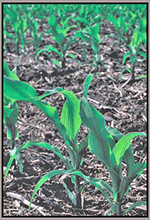
 Seedling success sometimes depends on a good coverup, according to research at the U.S. Department of Agriculture (USDA). Agricultural Research Service (ARS) plant physiologist Russ Gesch has determined that sowing seeds protected by a thin polymer layer can help northern Corn Belt farmers optimize spring planting schedules. ARS is USDA's chief intramural scientific research agency.
Seedling success sometimes depends on a good coverup, according to research at the U.S. Department of Agriculture (USDA). Agricultural Research Service (ARS) plant physiologist Russ Gesch has determined that sowing seeds protected by a thin polymer layer can help northern Corn Belt farmers optimize spring planting schedules. ARS is USDA's chief intramural scientific research agency.In Minnesota and other northern U.S. states, early spring planting in cold and wet soils can damage seeds. When farmers plant later in the season, a cold snap can interfere with seed response and result in poor plant emergence and poor yields.
Gesch, who works at the ARS Soil Management Research Unit in Morris, Minn., conducted several field studies comparing the performance of coated and uncoated seeds planted in early spring and late spring. The coated seeds were covered with a temperature-activated polymer that prevented water from reaching the seed until the soils were warm enough for germination and emergence.
In one study, the coated seeds planted in early spring had a significantly greater level of emergence and establishment than uncoated seeds planted at the same time. The rate of emergence-how long it took for 50 percent of the seeds to emerge and become established-was also faster for coated seeds than uncoated seeds.
However, coated seeds planted in late spring generally had slower emergence rates than uncoated seeds planted at the same time. According to Gesch, these findings strongly indicated that farmers could use coated seeds to get a jump-start on their spring planting because the seeds would be protected from cold, wet soils until conditions favored germination and emergence.
Gesch also examined how till and no-till cultivation affected seed response of corn and soybean seeds, and didn't find any significant differences in germination and emergence between coated seeds planted in conventional-till systems and seeds planted in no-till systems. But coated soybean seed planted in late spring was less successful because this left the seed exposed to soil temperatures that were too high for successful germination and establishment.
Read more about this research in the March 2014 issue of Agricultural Research magazine.
3.10.2014